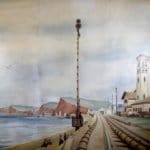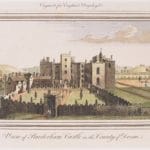Exminster
Exminster dates back to early Saxon times, more recently being favoured by the rich merchants of Exeter
who built fine homes here. The ‘County Lunatic Asylum’ was built here in 1846, its function now converted to residential use.
Powderham
Originally thought to have been ‘Polderham’, which meant ‘village of the marsh’. Powderham Castle, originally
a fortified manor house, was built during 1390-1420 by Sir Philip Courtenay and is now surrounded by a deer park of 2,000 acres.
St Clements’ Church is Grade II* listed, with the dolphin-shaped weather vane on the tower a remarkable medieval example.
The house and church came under siege during the English Civil War in 1645-46 during the Parliamentarian campaign to recapture Exeter.
Kenton
Local livelihoods included milling, salt making, salmon fishing, nurturing mussels and raking cockles and oysters. Kenton has a maritime history, dating back to before the River Kenn silted up, with six Kenton vessels included in a 1572 list of English merchant ships.
Kenton church is one of the finest examples of the Late Perpendicular style in the West of England. Its carved and
painted mediaeval rood screen is especially noteworthy
Starcross

Starcross was built largely by the Victorians, retaining much Victorian heritage in its buildings. In the 17th and 18th centuries Starcross became important for anchorage and trans-shipping when larger ships were unable to reach Topsham or Exeter. By the pier is the last of the Italianate campaniles that disguised the large chimneys of the engine houses of Brunel’s Atmospheric Railway, constructed in 1845
The Brunel Tower at Starcross is the best surviving remnant of Isambard Brunel’s famous Atmospheric railway, which was quickly abandoned after its completion in 1845. Today the Italianate pump house is home to the Starcross Fishing and Cruising Club, however Brunel’s endeavour is still commemorated by the Atmospheric Railway Inn, located opposite to the pumphouse.
Cockwood
Cockwood originated as a fishing village in the 13th century. There were once salt works and lime kilns here, while a pier and railway sidings were constructed in 1868 (now dismantled). The only record of the pier’s trade dates back to 1874 when the ‘Victoria’ discharged coal for Exeter, Teignbridge and Newton Abbot
Dawlish and Dawlish Warren
Dawlish became a fashionable resort in Regency times, with visitors including Jane Austen and Charles Dickens
(who used it as the birthplace of Nicholas Nickleby). The sea wall was built in 1836 to hold back erosion,
and the railway line later fulfilled the same function.
In 1855 there was a major cliff fall that carried a section of the railway track into the sea, with similar incidents
in 1869 and 1872. In 1885 the cliff was cut back and the promenade created after a fatal accident.
Exeter Canal
In 1284, Isabella de Fortibus, Countess of Devon, made two weirs across the river upstream of Topsham to drive a new mill, leaving a 30’ gap to allow shipping to pass. When Hugh de Courtenay, Earl of Devon, inherited Isabella’s titles and possessions, he stopped the gap, forcing all Exeter-bound ships to unload at Topsham, adding to his wealth. This continued for over 200 years until 1538, when Henry Courtenay was executed and his lands forfeited to the crown for alleged conspiracy against Henry VIII. Efforts to re-open the weir failed and it was decided that a canal by-passing the weirs provided the only solution. Built by John Trew during 1564 – 1566, this was the first canal in England to use the pound-lock.
Countess Wear
Soon after 1688 a sugar refinery and glass factory were built at Countess Wear, the sugar being imported from the West Indies. Messrs Harris and Son made high quality paper in one of the earliest paper mills in Devon, operating before 1704 and closing in 1887. There were several lime kilns, the last of which ceased burning in 1914. Shipbuilding was carried out at Countess Wear, with 13 vessels being built between 1792 and 1812.
Topsham
Dutch-influenced architecture came via the strong wool trade links with Holland. There was a windmill grinding corn for export, salt works and limekilns. Manufacturing industries peaked in the late 17th century, whilst Topsham’s reputation for shipbuilding peaked in the 19th century, when Robert Davy built 27 ‘small’ warships for the Royal Navy during the Napoleonic wars. The principal port for Exeter in the 14th century, its subsequent decline partly due to the construction of railways and modern iron ships being too large for the shallow river Exe. The industrial revolution in the north devastated Topsham’s commercial importance.
Exton
The emergence of Exton in 1242 was probably linked to development of a water mill, which led to the construction
of a road to take corn from the Great Field to Exton by 1321, later known as Rydon Lane. In 1868, the two water mills at Rydon and Exton were experiencing serious difficulties in dry weather. Rydon Mill stopped production in 1909, and Exton Mill stopped in the early 1920s.
Lympstone
A well-known port by the 14th century and rose to prominence for shipbuilding in the 18th century.
Heavily involved in whale fishing in the Arctic, the subsidy was withdrawn in 1787 (probably to the relief of local residents, since blubber was boiled in cauldrons on the boatyard) and the town became known as ‘a notorious haven of smugglers’. Many cottages near the river had nooks to hide smuggled goods and adapted roof spaces enabling the passing of goods between houses.
Exmouth
In the early 18th-19th century, Exmouth attracted wealthy people who enjoyed the sea views and bathing areas, including Lady Nelson and Lady Byron.
Exmouth served as an important port for over 700 years, from the early 12th century onwards, with the construction of a formal dock in the mid-1860s. However, economic decline and the closure of Exmouth station’s branch lines to the docks in the mid 20th century led to their closure in 1989.
